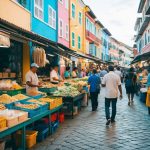The Ultimate DIY Travel Planning Guide: Steps for Crafting Your Ideal Adventure
Utilizing Travel Budget Tools and Apps
There are several tools and apps designed to help manage your travel budget effectively. Apps like Trail Wallet, TravelSpend, and TrabeePocket allow travelers to track spending in real-time. These apps can categorize expenses, offer budget reminders, and provide detailed expenditure reports. Many of these tools sync data across devices, making it easier to monitor your budget from anywhere.
Some apps also help with initial budgeting by suggesting costs based on destination and travel style. Additionally, consider using currency converter apps to understand local prices and prevent overspending. Using these tools ensures you stick to your budget and identifies areas where you might need to adjust spending.
Choosing Your Destination
Selecting a travel destination involves balancing personal interests, budget, and timing. By thoroughly researching and considering the best times to visit, one can ensure a more enjoyable and cost-effective trip.
Researching Potential Locations
Evaluating potential travel destinations provides an exciting start to any trip planning process. It involves considering various factors like cultural interests, budget constraints, and safety. Travelers should use multiple resources, such as travel blogs, guidebooks, and forums, to gather comprehensive information about possible locations. Websites like TripAdvisor or Lonely Planet offer extensive reviews and practical travel tips.
Another crucial consideration is accessibility. Check for direct flights or connections, as well as visa requirements. Think about the local language, availability of English speakers, and potential health advisories. Budget considerations play a major role too. Accommodation, food, transportation, and local activities should fit within the traveler’s financial plan. Gathering this information helps in shortlisting destinations that align with personal preferences and requirements.
Considering Peak and Shoulder Seasons
Timing a trip correctly can significantly affect the experience. Understanding peak and shoulder seasons of different destinations allows for informed decisions. Peak season typically means higher prices and larger crowds but also more activities and better weather. This season varies depending on the location; for instance, European cities are busiest in summer, while ski resorts peak in winter.
Shoulder seasons are the transition periods between peak and off-peak times. These offer a great balance of reasonable prices, fewer tourists, and generally good weather. For example, Southeast Asia is more pleasant in spring and autumn, avoiding the intense summer heat and monsoon season. By aligning travel dates with shoulder seasons, travelers can gain a more relaxed experience and often discover local traditions and festivals that are less commercialized.
Crafting Your Itinerary
Creating the perfect travel itinerary involves detailed planning, allowing flexibility, and managing activities and sightseeing to maximize your trip.
Detailed Itinerary Planning
When crafting a travel itinerary, it’s crucial to include specific details. This includes noting down flight times, accommodation addresses, and transfer arrangements. Detailed planning ensures a smooth journey. Travelers benefit from including contact information for hotels and transport services. Additionally, highlighting estimated travel times between destinations helps anticipate and mitigate potential delays.
Allocating time for major attractions and activities is vital. Prioritizing must-see spots ensures they are not missed, giving structure to the trip. Frequently checking operating hours and booking tickets ahead of time can prevent any last-minute hiccups. With these details in hand, the itinerary becomes a reliable guide throughout the trip.



